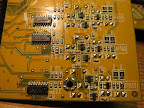The Focusrite Scarlett 6i6 is a 2 Mic, 2 Line, 2 Digital input, 4 Line, 2 Digital output audio interface and is presented to the Linux machine as a 12 output, 6 input USB2.0 class compliant soundcard. Strange, but that's what it is. Now, pulseaudio, not very smart in the first place, gets confused and only ever wants to use this card as a "multichannel" output, with outputs 1/2 deprived of bass, and output 6 (typically mapped to the s/pdif output) being a subwoofer. Not useful when listening over headphones.
After looking through the non-existing pulseaudio-documentation regarding udev, and searching on the web, I've came up with a workaround. This is at least useful to use the card as a normal stereo output.
To get output on the 2nd headphone output, use alsamixer to map Master 2L and Master 2R source to PCM1 and PCM2. The same applies to the S/PDIF output (Master 3L/R).
Bug filed.
➜ ~ cat /usr/share/pulseaudio/alsa-mixer/profile-sets/focusrite-scarlett-6i6.conf
; Based on native-instruments-traktor-audio10.conf
;
; Focusrite Scarlett 6i6 has 6 physical inputs/outputs
; Inputs
; 2x Microphone/Line on front
; 2x Line on back
; 2x S/PDIF coaxial on back
; Outputs
; 2x Headphone (Out1/2, Out 3/4) on front
; 2x Line on back (Out 1..4)
; 2x S/PDIF coaxial on back
;
; It's presented as a 6 input, 12 output interface to the PC, so
; we have to create some mappings. Actual routing is configurable
; in ALSA mixer. I prefer a 1:1 mapping to physical outputs.
;
[General]
auto-profiles = no
[Mapping analog-out]
description = Analog Outputs
device-strings = hw:%f
channel-map = left,right,aux0,aux1,aux2,aux3,aux4,aux5,aux6,aux7,aux8,aux9
[Mapping analog-in]
description = Analog Inputs
device-strings = hw:%f
channel-map = left,right,aux0,aux1,aux2,aux3
direction = input
[Profile output:analog-out+input:analog-in]
description = Analog Duplex
output-mappings = analog-out
input-mappings = analog-in
priority = 100
skip-probe = yes
➜ ~ cat /etc/udev/rules.d/99-pulseaudio-local.rules
SUBSYSTEM!="sound", GOTO="pulseaudio_local_end"
ACTION!="change", GOTO="pulseaudio_local_end"
KERNEL!="card*", GOTO="pulseaudio_local_end"
SUBSYSTEMS=="usb", GOTO="pulseaudio_local_check_usb"
LABEL="pulseaudio_local_check_usb"
##
# The Focusrite Scarlett 6i6 only runs as 12 playback and 6 capture channels!
# (mappable using the internal mixer)
# Bus 002 Device 004: ID 1235:8012 Focusrite-Novation Scarlett 6i6
##
ATTRS{idVendor}=="1235", ATTRS{idProduct}=="8012", ENV{PULSE_PROFILE_SET}="focusrite-scarlett-6i6.conf"
LABEL="pulseaudio_local_end"



















